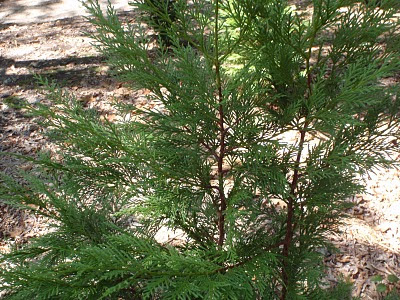100 Species Catch-up
We tried to get a big start on our 100 Species Challenge during one nature walk. The first couple of entries were fun; we went a little overboard with the camera for one walk, though. We got so many I just shut down. Hey, there were nine of us grabbing species pics. I decided to knock a few out here.
"Leyland Cypress" describes a group of evergreens popular in landscaping. My husband loves them for their rapid growth and their sound-deadening capabilities, although supposedly they don't do well in the drought-prone South because of their shallow root system. They are a sterile conifer hybrid, so you're not really going to see them growing wild.

American Beautyberry. A few years ago, we temporarily mistook it for pokeberry (which we now know well--see below). After a Google image search, though, we easily identified this shrub by its cluster of bright purple berries. It's prized as an ornamental shrub and for attracting birds. Who knew--it grows wild all around here.

A wildflower/weed that I never thought much about, except when little ones picked me their tiny bouquets. Hey, flowers are flowers in their eyes. This tiny, stringy--but oddly pretty--thing is Gregg's mistflower, which is in fact planted on purpose sometimes, probably because butterflies like it. And there's that light lavender color--blues and purples seem to be sought after, maybe because they are less common? All my information on this one seems to come from Texas.

American holly. We have holly (American or English--I haven't figured out which yet--!) in our landscaping around the house, but this is some that grows wild that we found on our walks. From its height, pyramidal shape, and spiny leaves, we determined that this is American holly. It can grow 3o to 60 feet, has glossy evergreen leaves that are spined all along the edges, and are a little lighter green than English holly. (The light green can also be the result of new growth.) I think this may be the only wild one around, which explains why there are no ripening berries--holly is either male or female and needs to be pollinated by a nearby plant of the opposite sex to produce fruit.


 ----
----
----

----

----

----

----
Two pictures for this one--pokeberry. (Sorry for the holey specimen. The birds and caterpillars have gotten to it--winter's a-coming.)

If this thing gets a decent start from the ground in the spring, by summer's end it is a lush four feet tall, at least. It's got a long, folksy history. Check out this tidbit from Wikipedia:
Young leaves, if collected before acquiring a red color, are edible if boiled for 5 minutes, rinsed, and reboiled. Berries are toxic when raw but cooked juice is edible (the seeds remain toxic after cooking). However, it may be difficult to identify exactly when leaves have no red color whatsoever; an incorrect picking may result in a poisoning.
Come to think of it, I think I remember Jason's grandpa (who first told us what this was) mentioned something about "poke salad." There are all kinds of rumored medicinal uses, too. I think I'll just play it safe, though.
Besides being poisonous through and through, its berries are used to make dye. Now, that I'd be willing to experiment with. Just look at those berries--you know those can mess up some clothes.

So there you have it.
1. Dogwood (Cornus florida)
2. Mockernut hickory (Carya tomentosa)
2. Mockernut hickory (Carya tomentosa)
3. Leyland cypress (Cupressocyparis leylandii)
4. American beautyberry (Callicarpa americana)
5. Gregg's mistflower (Conoclinium greggii)
6. American holly (Ilex opaca)
7. Pokeberry (Phytolacca americana)

Comments